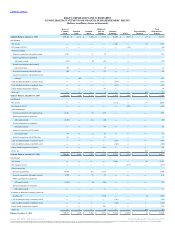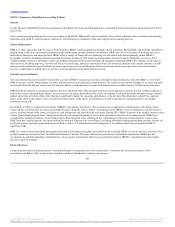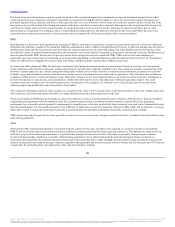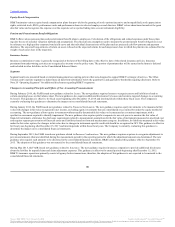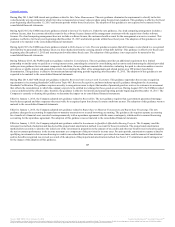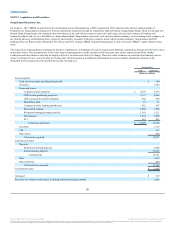BB&T 2015 Annual Report Download - page 101
Download and view the complete annual report
Please find page 101 of the 2015 BB&T annual report below. You can navigate through the pages in the report by either clicking on the pages listed below, or by using the keyword search tool below to find specific information within the annual report.
TableofContents
Purchased loans are evaluated upon acquisition and classified as either purchased impaired or purchased non-impaired. Purchased impaired loans reflect
credit deterioration since origination such that it is probable at acquisition that BB&T will be unable to collect all contractually required payments. For
purchased impaired loans, expected cash flows at the acquisition date in excess of the fair value of loans are recorded as interest income over the life of the
loans using a level yield method if the timing and amount of the future cash flows is reasonably estimable. Subsequent to the acquisition date, increases in
cash flows over those expected at the acquisition date are recognized prospectively as interest income. Decreases in expected cash flows due to credit
deterioration are recognized by recording an ALLL. For purchased non-impaired loans, the difference between the fair value and UPB of the loan at the
acquisition date is amortized or accreted to interest income over the estimated life of the loans using the effective interest method.
TDRs
Modifications to a borrower’s debt agreement are considered TDRs if a concession is granted for economic or legal reasons related to a borrower’s financial
difficulties that otherwise would not be considered. TDRs are undertaken in order to improve the likelihood of recovery on the loan and may take the form of
modifications made with the stated interest rate lower than the current market rate for new debt with similar risk, other modifications to the structure of the
loan that fall outside of normal underwriting policies and procedures, or in certain limited circumstances forgiveness of principal or interest. Modifications of
loans acquired from the FDIC that are part of a pool accounted for as a single asset are not considered TDRs. TDRs can involve loans remaining on
nonaccrual, moving to nonaccrual, or continuing on accruing status, depending on the individual facts and circumstances of the borrower. In circumstances
where the TDR involves charging off a portion of the loan balance, BB&T typically classifies these TDRs as nonaccrual.
In connection with commercial TDRs, the decision to maintain a loan that has been restructured on accrual status is based on a current, well documented
credit evaluation of the borrower’s financial condition and prospects for repayment under the modified terms. This evaluation includes consideration of the
borrower’s current capacity to pay, which among other things may include a review of the borrower’s current financial statements, an analysis of cash flow
available to pay debt obligations, and an evaluation of secondary sources of payment from the client and any guarantors. This evaluation also includes an
evaluation of the borrower’s current willingness to pay, which may include a review of past payment history, an evaluation of the borrower’s willingness to
provide information on a timely basis, and consideration of offers from the borrower to provide additional collateral or guarantor support. The credit
evaluation may also include review of cash flow projections, consideration of the adequacy of collateral to cover all principal and interest and trends
indicating improving profitability and collectability of receivables.
The evaluation of mortgage and retail loans includes an evaluation of the client’s debt to income ratio, credit report, property value, loan vintage, and certain
other client-specific factors that impact their ability to make timely principal and interest payments on the loan.
Nonaccrual commercial TDRs may be returned to accrual status based on a current, well-documented credit evaluation of the borrower’s financial condition
and prospects for repayment under the modified terms. This evaluation must include consideration of the borrower’s sustained historical repayment
performance for a reasonable period (generally a minimum of six months) prior to the date on which the loan is returned to accrual status. Sustained historical
repayment performance for a reasonable time prior to the TDR may be taken into account. In connection with retail TDRs, a NPL will be returned to accruing
status when current as to principal and interest and upon a sustained historical repayment performance (generally a minimum of six months).
TDR classification may be removed for a loan upon the occurrence of a non-concessionary subsequent modification that is at market terms and within current
underwriting guidelines.
NPAs
NPAs include NPLs and foreclosed property. Foreclosed property consists of real estate and other assets acquired as a result of customers’ loan defaults.
BB&T’s policies for placing loans on nonaccrual status conform to guidelines prescribed by bank regulatory authorities. The majority of commercial loans
and leases are placed on nonaccrual status when it is probable that principal or interest is not fully collectible, or generally when principal or interest
becomes 90 days past due, whichever occurs first. Other lending subsidiaries’ loans, which includes both retail and commercial loans, are placed on
nonaccrual status generally when principal and interest becomes 90 days past due. Direct retail, mortgage and sales finance loans are placed on nonaccrual
status at varying intervals, based on the type of product, generally when principal and interest becomes between 90 days and 120 days past due. PCI loans are
considered to be performing due to the application of the expected cash flows method.
90
Source: BB&T CORP, 10-K, February 25, 2016 Powered by Morningstar® Document Research℠
The information contained herein may not be copied, adapted or distributed and is not warranted to be accurate, complete or timely. The user assumes all risks for any damages or losses arising from any use of this information,
except to the extent such damages or losses cannot be limited or excluded by applicable law. Past financial performance is no guarantee of future results.





